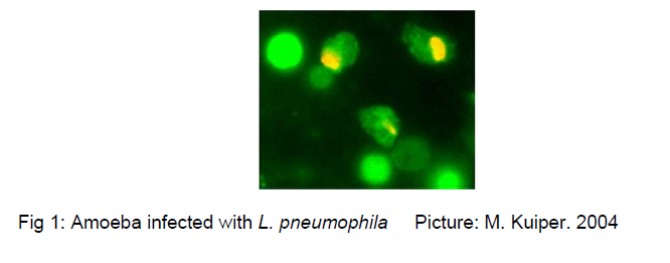Project
Elucidation of relationships between protozoa, Legionella pneumophila and biofilm concentrations in tap water installations
A major Legionellosis outbreak at a flower show in the Netherlands in 1999 caused 31 deaths and more than 200 diseased visitors. This outbreak was caused by the bacteria Legionella pneumophila which had multiplied in a whirlpool on display. L. pneumophila is ubiquitous in the natural aquatic environment and is also a common inhabitant of engineered water systems such as cooling towers and hot water systems. Although 50 Legionella species have been defined, L. pneumophila is responsible for more than 90% of the reported causes of Legionellosis.
Growth of L. pneumophila depends on the presence of protozoa serving as host. Protozoa provide nutrients for the intracellular Legionella, but also form a shelter when environmental conditions become unfavorable. Protozoa are unicellular eukaryotic organisms that belong to the kingdom of Protista. Fourteen species of amoebae and two species of ciliated protozoa have been identified as host for Legionella species that could be linked to cases of Legionnaires’ disease. Grown of these Legionella is detected in protozoa of the genera Hartmannella, Acanthamoeba, Naegleria, Saccamoeba, Tetrahymena, Vexillifera and Platyamoeba. Protozoa provide nutrients for the intracellular Legionella, but also form a shelter when environmental conditions become unfavorable. For limiting the multiplication of L. pneumophila knowledge is needed about host protozoa and physical conditions affecting the multiplication of these organisms in tap water and biofilms.

Aim
The aim of this project is to apply molecular and cultivation techniques to identify and quantify protozoa comminutes in tap water installations and biofilms. With these techniques we will develop a model that predicts the grown of L. pneumophila in host protozoa in biofilms.
Research Approach
Field experiments
To identify protozoa communities in tap water, distributions systems and warm water installations, samples will be taken from different supply areas in the Netherlands. From these samples DNA will be isolated and with the molecular techniques the eukaryotic community will be identified. This study will show use the diverse world of eukaryotes and especially the protozoa in tap water, distribution systems and warm water installations in the Netherlands.
Laboratory experiments
To elucidate the relationship between protozoa, L. pneumophila and biofilm concentrations, dynamic biofilm monitors and statically batch systems will be used. Grown of L. pneumophila and protozoa in the biofilm will be measured with molecular techniques. We hope to learn more about the grow conditions of L. pneumophila in water installations.
Methods
- DNA isolation
- PCR
- Quantitative PCR
- Cloning
- Sequencing
- Terminal-Restriction Fragment Length Polymorphism (T-RFLP)
- Fluorescent in Situ Hybridization (FISH)
- Cultivation of protozoa (axenic and monoxenic)
Student projects available
Researcher: Rinske Valster
Elucidation of relationships between protozoa, Legionella pneumophila and biofilm concentrations in tap water installations.